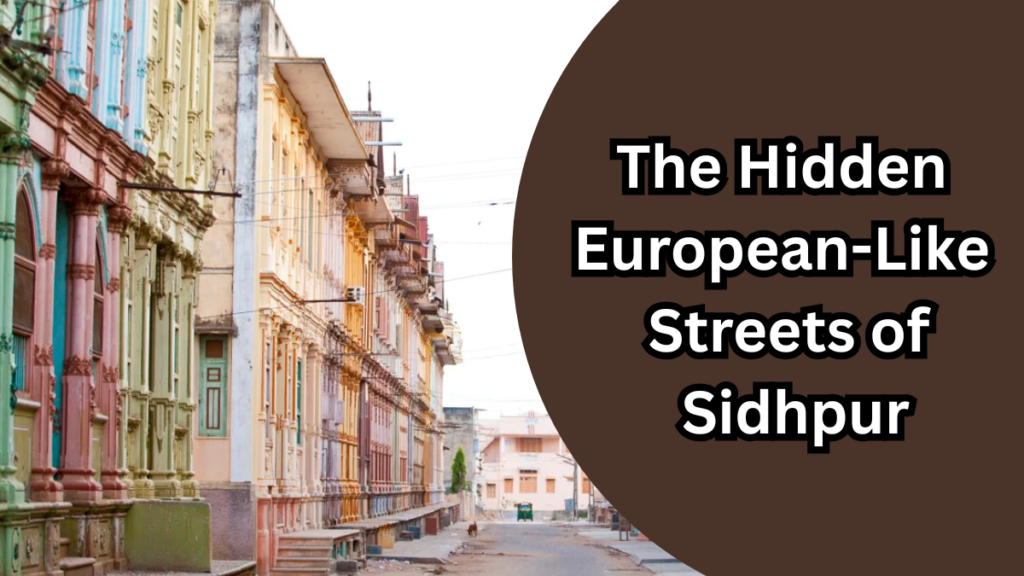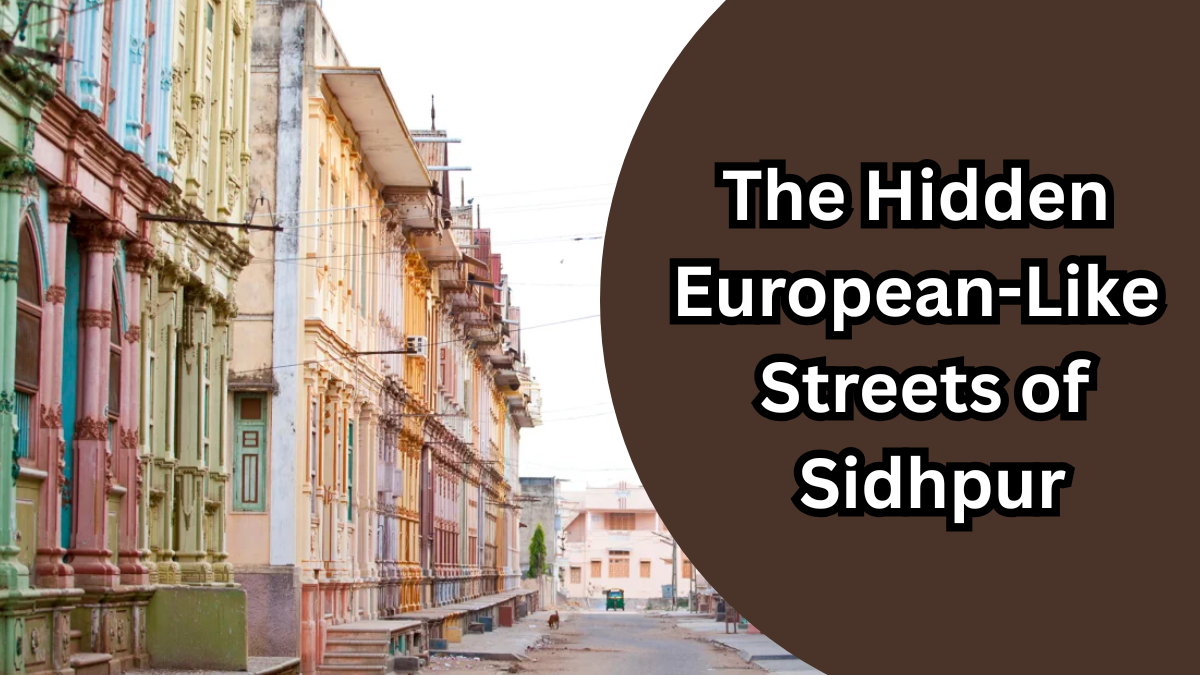As you journey along the arid, camel-dotted highway toward Sidhpur, a quiet town nestled in Gujarat, India, nothing quite prepares you for the sight ahead. The route feels like any other rural Indian road—dusty, dotted with dhabas (roadside eateries), and framed by parched earth. But once you step into the Najampura district, you’re suddenly transported to what looks like a pastel-hued version of a European neighborhood.
Welcome to Paris Galli—a street unlike any other in India.

Paris Galli: A Slice of Europe in Western India
Lined with three- and four-story havelis (mansions) in candy-colored shades of teal, pink, pistachio green, and baby blue, Paris Galli is an architectural marvel. The homes whisper tales of a bygone era when Dawoodi Bohras, a Shia Muslim trading community, made Sidhpur their cultural and economic epicenter.
Architectural Styles on Display:
-
Neoclassical elegance
-
Art Deco charm
-
Baroque elements
-
Gujarati-Indian hybrid designs
These aren’t mere homes—they’re visual stories built in wood, plaster, and brick.
Who Are the Dawoodi Bohras?
The Dawoodi Bohras originally hailed from Egypt and migrated through the Middle East before settling in India in the 11th century. Known for their enterprising spirit, they traded in:
-
Spices
-
Gems
-
Perfumes
Their wealth was eventually translated into real estate—hundreds of stately mansions built in Sidhpur during the early 1900s.
How Sidhpur Became a Bohra Haven
Thanks to their generosity during a famine in the early 20th century, the Maharaja of Baroda, Sayajirao Gaekwad III, gifted the Bohras a plot of land. Under the influence of Scottish planner Patrick Geddes, the town followed a strict urban layout.
| Influencer | Contribution |
|---|---|
| Sayajirao Gaekwad III | Donated land for Bohra housing |
| Patrick Geddes | Inspired structured urban design |
| Dawoodi Bohras | Built pastel mansions showcasing hybrid architecture |
These mansions became symbols of prestige and communal pride, often outdoing one another in luxury—from Belgian glass windows to imported chandeliers.
A Peek Inside the Bohra Havelis
Local tour guide Insiya Bangalorewalla offers insights into the typical floor plan of a Bohra haveli. Despite their closed facades, these homes are intricate marvels inside.
| Section | Purpose |
|---|---|
| Dehli | Entrance/service area |
| Chowk | Courtyard kitchen, open to the sky |
| Outer Pursaal | Multipurpose dining/living room |
| Inner Pursaal | Coolest room, typically used as a bedroom |
| Orda | The most lavish room, reserved for the family head |
Interior Highlights:
-
Persian carpets and rosewood furniture
-
Belgian mirrors and antique family memorabilia
-
Water niches (marble alcoves for purification rituals)
-
Monogrammed facades with English initials
“From the street you can’t see into the house thanks to a veil called the ‘furtaal,’ which protected the privacy of the women,” says Bangalorewalla.
The Story Behind the Architecture
According to conservation architect Ashish Trambadia, these homes blend rhythm and diversity:
-
Each house has a unique color palette and grill work
-
Gabled roofs, carved jharokhas, and pilasters lend European flair
-
Yet, local materials like wood (ideal for earthquake-prone zones) anchor them in Indian tradition
Photographer Sebastian Cortés, who documented the area in his series “Sidhpur: Time Present Time Past,” calls it “inverse colonialism.” The Bohras didn’t just absorb Western aesthetics—they blended global influences with local traditions and commissioned Hindu artisans to build homes fit for their Islamic values.
Famous Bohra Mansions of Sidhpur
Some of these homes have become iconic over time, each with its own tale.
| Mansion Name | Highlights |
|---|---|
| Zaveri House | Known as the “House with 365 Windows”; now weather-worn and crumbling |
| Teen Khuniya | “Three-Cornered House” with a distinct triangular structure |
| Zainab Mansion & Kagalwala Manor | Named after prominent families who once lived there |
The Decline: Fading Glory of the Bohra Havelis
After India’s independence in 1947, many Bohras migrated to:
-
Mumbai
-
Ahmedabad
-
Overseas (Gulf, UK, Africa)
Without their original caretakers, these homes began to deteriorate. Today:
| Year | Approximate Number of Havelis |
|---|---|
| 1970s | 1,400+ |
| Present | Less than 400 occupied |
Many havelis are now:
-
Locked up and forgotten
-
In legal limbo
-
Sold for parts—antiques, doors, and timber
Preserving the Legacy: A Glimmer of Hope
In 2024, architect Zoyab A. Kadi co-founded the Sidhpur Heritage Collective, a grassroots effort to:
-
Document the mansions
-
Conduct tours and workshops
-
Raise awareness about Sidhpur’s historical relevance
“There are no heritage laws protecting private mansions in India,” Kadi laments. “Even converting them into homestays or Airbnbs hasn’t caught on yet.”
Why Sidhpur Matters More Than Ever?
Sidhpur isn’t just about beautiful architecture. It’s a melting pot of culture, faith, craftsmanship, and history. Beyond the havelis, visitors can explore:
-
Jain and Hindu temples
-
Majestic mosques
-
Rich Dawoodi Bohra cuisine
But the clock is ticking.
Without intervention, these architectural treasures may disappear forever—unless public support, funding, and policy catch up in time.
FAQs
1. What makes Paris Galli in Sidhpur unique?
Paris Galli is a rare street in India lined with European-style pastel mansions built by the Dawoodi Bohras. Its architectural fusion of Neoclassical, Art Deco, and Indian styles is unmatched.
2. Can tourists visit the Bohra havelis in Sidhpur?
Yes, some of the havelis can be viewed from the outside, and guided tours are available, especially through the Sidhpur Heritage Collective.
3. Why are many havelis abandoned today?
Post-independence, many Bohra families migrated, leaving homes under caretaker supervision or legal disputes. As a result, many have deteriorated or been demolished.
4. Is Sidhpur recognized as a heritage site by the Indian government?
Currently, there are no national heritage laws that specifically protect privately owned havelis in Sidhpur, though conservation efforts are ongoing through private collectives.
Click here to learn more
Pari is a passionate writer known for captivating stories that blend imagination and reality. Inspired by travel, history, and everyday moments, Pari crafts narratives that resonate deeply with readers.
